Culture statistics - use of ICT for cultural purposes
Data extracted in July 2023.
Planned article update: August 2024.
Highlights
For EU internet users, watching online video content is becoming more popular than reading news online.
In 2022 men are still more likely than women to look online for cultural content, although the gap is slowly narrowing.
In 2022, 14% of EU internet users bought printed books, magazines, or newspapers online, while 7% bought e-books, online magazines, or newspapers for digital reading.
This article forms part of an online publication Culture statistics.
Over the years, information and communication technologies (ICTs) have become the most common way of accessing culture for large parts of the society throughout the European Union (EU). Looking at this phenomenon via the annual survey on ICT usage in households and by individuals, Eurostat focused on two socio-economical aspects:
- use of the internet for selected cultural activities:
- watching streamed TV or videos
- reading online news sites/newspapers/news magazines
- listening to music (web radio, music streaming), downloading music
- playing or downloading games
- use of the internet for purchasing selected cultural goods and services:
- printed books, magazines or newspapers
- e-books, online magazines or online newspapers
- films or series, on DVD, Blu-ray, etc.
- films or series as a streaming service or downloads
- music on CDs, vinyl, etc.
- music as a streaming service or downloads
- games online or as downloads for various kind of devices
- tickets to cultural or other events
In the context of this article, the term 'internet users' refers to all individuals in the EU aged 16 to 74 who actively used the internet in the 3 months prior the ICT use survey data collection.
Full article
Internet use for cultural purposes
Main patterns, by cultural activity
Using the internet for cultural purposes ‒ first, to watch and read, then to listen and play games
In 2022, nine out of ten (90 %) persons in the EU, aged between 16 and 74 years, used the internet at least once within the three months prior to the survey date.[1]
Culture-related activities are popular on the internet. In 2022, 72 % of users in the EU watched internet-streamed TV or videos. Other popular cultural activities were reading online news sites/newspapers/news magazines (71 %), listening to or downloading music (60 %), and playing or downloading games (32 %).
As shown in Figure 1, at national level, the two most common forms of online cultural activities were usually watching streamed TV or videos and reading online news sites/newspapers/news magazines. One of these two activities was the most popular in 23 EU countries. In Bulgaria, Greece, Portugal and Romania, the most popular cultural use of the internet was reading online news sites/newspapers/news magazines followed by listening to or downloading music. Playing or downloading games was the least favoured use in all EU countries. The highest share of internet users who played or downloaded games were recorded in the Netherlands and Denmark, with rates of 55 % and 50 %, respectively.
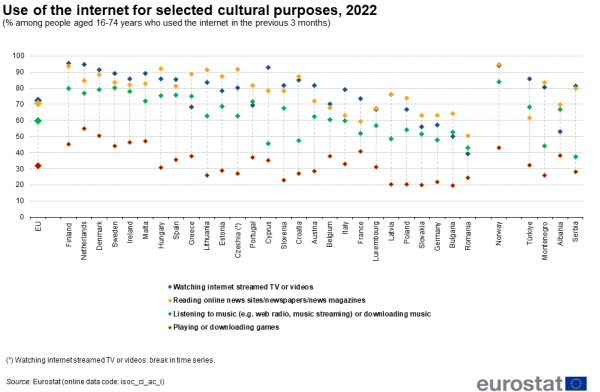
(% among people aged 16-74 years who used the internet in the previous 3 months)
Source: Eurostat (isoc_ci_ac_i)
Analysis by socioeconomic characteristics
In this section we present 2022 data on the use of the internet for selected cultural purposes by main socio-economic characteristics. These include age, sex, level of educational attainment, household income, degree of urbanisation and economic status (see Table 1).
The data shows that people under 45 were more likely than the total population to use the internet for cultural purposes. However, among young individuals aged 16-24, the usage rate for reading online news sites/newspapers/news magazines was below the value of the total population (by 4 percentage points, pp). Conversely, the rate for individuals aged 25-34 and 35-44 who used the internet for reading online news sites/newspapers/news magazines was the highest among all age groups, reaching 75 %.
Men were more likely than women to use the internet for cultural purposes. This pattern was confirmed for all four selected cultural activities. Among internet users, more men than women watched internet-streamed TV or videos (74 % compared to 70 %), listened to or downloaded music (62 % compared to 57 %), and played or downloaded games (36 % compared to 28 %). The smallest difference between men and women was recorded for reading online news sites/newspapers/news magazines, where the share for men was 72 %, 3 pp higher than that for women.
People with higher education used the internet for cultural purposes more than those with lower education levels. It was the most notable for reading online news sites/newspapers/news magazines, where 83 % of the EU internet users with a higher education used the internet for this purpose. Of the four cultural activities covered by the ICT use survey, only playing or downloading games had a different pattern. Most internet users using the internet for that purpose had the lowest level of formal education (38 %).
Internet users living in cities were more inclined to use the internet for cultural purposes than those living in towns and suburbs, or rural areas.
Regarding the economic status (employed, unemployed, students, and economically inactive people other than students), students used the internet for cultural purposes more than people with other economic statuses did. Almost all students (who were internet users) watched online TV or videos (90 %) or listened to or downloaded music (88 %). In addition, more than half of the students played or downloaded games (62 %). Of all internet users with different economic statuses, employed people were most likely to read online news sites/newspapers/news magazines (74 %).
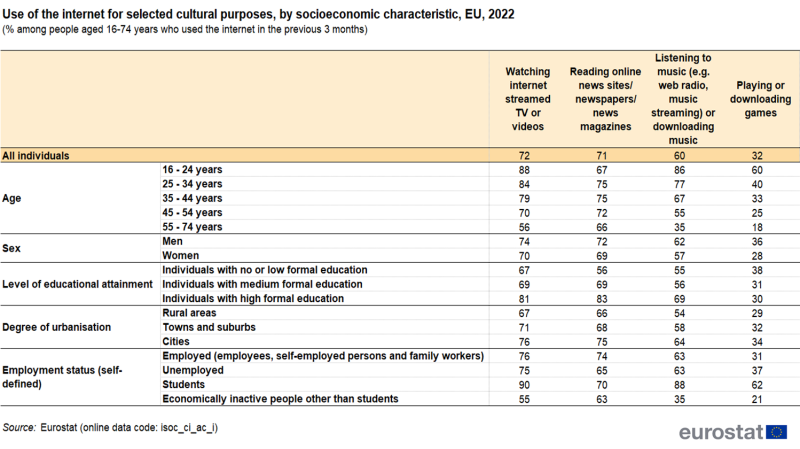
(% among people aged 16-74 who used the internet in the previous 3 months)
Source: Eurostat (isoc_ci_ac_i)
Focus on the two most popular online cultural activities
Internet users' preferences shift towards watching video content
In 2022, the most popular forms of cultural activities online were watching internet-streamed TV or videos and reading online news/newspapers/news magazines. When comparing the 2022 data to 2016, both activities increased in popularity over the years, with watching video content showing a more pronounced increase. In 2016, watching internet-streamed TV or videos was less frequent among internet users compared to reading online news sites/newspapers/news magazines (68 % vs 70 %). However, in 2022, the situation reversed, with 72 % of internet users watching TV shows or videos online and 71 % reading news online. Furthermore, between 2016 and 2022, watching internet-streamed TV or video saw an increase in popularity among internet users across all the available social characteristics, while reading online news sites/newspapers/news magazines saw a decline in some of them.
Considering the age groups, watching video content remained particularly popular among young internet users. Between 2016 and 2022, the proportion of individuals aged 16-24 who watched streamed TV or video increased by 2 pp, reaching 88 % in 2022. However, the most significant increases in online video consumption over this period were seen among individuals aged 35-44 and 45-54, with an increase of 8 and 9 pp, respectively. In 2022, 79 % of internet users aged 35-44 and 70 % of those aged 45-54 watched internet-streamed TV or video.
The increase in popularity of reading online news sites/newspapers/news magazines was seen exclusively among internet users aged 35-44 and 45-54. The growth was relatively modest, with a 3 pp increase in both age groups. In 2022, 75 % of individuals aged 35-44 and 72 % of those aged 45-54 read online news, newspapers, or news magazines. The lowest percentage of people who read online news content was seen among the youngest (67 %) and the oldest (66 %) internet users in the same year.
In 2022, more men than women watched video content on the internet, but the gap narrowed compared to six years earlier. In 2022, 70 % of women and 74 % of men watched internet-streamed TV or videos. This represented a 6 pp increase for women and a 4 pp increase for men compared to 2016. In terms of reading news online, in 2022, 69 % of women and 72 % of men used the internet for this purpose. Among women, there was a 1 pp increase compared to 2016, while the percentage of men stayed the same (see Figure 2a).
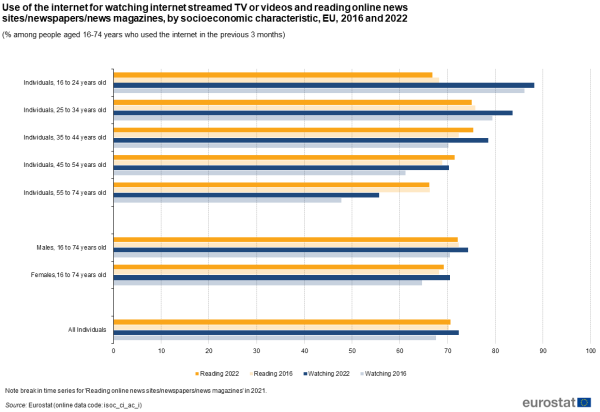
(% among people aged 16-74 years who used the internet in the previous 3 months)
Source: Eurostat (isoc_ci_ac_i)
The proportion of internet users watching streamed TV or videos online increased differently based on whether they lived in a city, town, or rural area. Compared to 2016, the share of people using the internet for watching video content among those living in cities increased by 6 pp, reaching 76 % in 2022. Among individuals living in rural areas, this share increased by 5 pp, reaching 67 %. Among those living in towns and suburbs, the share of individuals watching internet-streamed TV or videos increased by 3 pp, reaching 71 %. Between 2016 and 2022, the usage of the internet for watching internet streamed TV or videos became more popular than reading online news sites/newspapers/news magazines regardless of the degree of urbanization. Over this period, the share of internet users living in cities and rural areas who read online news increased only by 1 pp, reaching 75 % and 66 %, respectively, and the share of those living in towns and suburbs who read online news decreased by 1 pp, reaching 68 %.
When analysing internet users according to education attainment levels, data show that watching TV or movies streamed online became increasingly popular, while internet use for reading online news services/newspapers/news magazines remained stable over the years across all levels. Compared with 2016, in 2022, online video content was watched by 81 % of individuals with higher education (an increase of 7 pp), 69 % of individuals with medium-level education (an increase of 5 pp), and 67 % of individuals with no or lower level education. In contrast, the percentage of individuals using the internet for reading online news sites/newspapers/news magazines was 83 % for those with higher education, 69 % for those with medium formal education, and 56 % for those with no or low formal education. Internet users with high formal education tended to read online news more often than those representing other education attainment levels. In addition, among these users, reading online news sites/newspapers/news magazines was 2 pp more popular in 2022 than watching streamed TV or videos online (see Figure 2b).
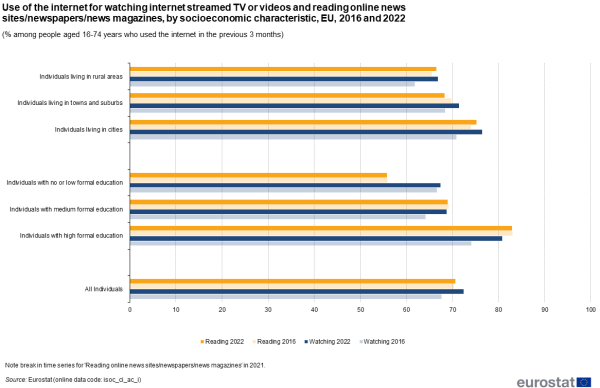
(% among people aged 16-74 years who used the internet in the previous 3 months)
Source: Eurostat (isoc_ci_ac_i)
Internet use to buy cultural goods and services
E-commerce in cultural contents on physical media vs on-line media was significant only for printed books
In 2022, among the surveyed cultural goods and services, internet users in the EU most often bought access to films or series via streaming or downloads (19 %), tickets to cultural and other events (18 %), and access to music via streaming or downloads (16 %). For online purchases, internet users chose streaming or downloadable video content almost six times more and music streaming or downloadable content four times more than the same kind of product on physical media (19 % compared to 3 %, and 16 % to 4 %, respectively). The opposite effect was seen for buying books: 14 % of internet users in the EU used the ICT to buy printed books, magazines or newspapers, while e-books, online magazines or online newspapers were chosen only by 7 % (see Figure 3).
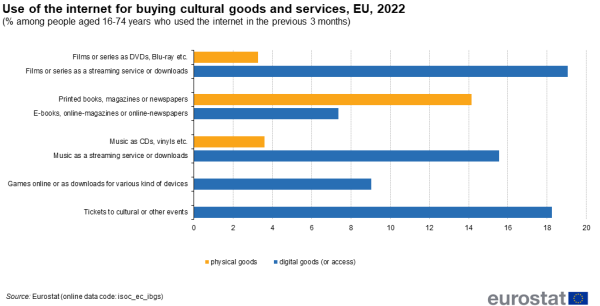
(% among people aged 16-74 years who used the internet in the previous 3 months)
Source: Eurostat (isoc_ec_ibgs)
Analysis by socioeconomic characteristics
Online purchasing of any kind of the selected cultural contents was more popular among people with higher education
In 2022, EU internet users aged 16-24 and 25-34 were more likely than people in other age groups to make online purchases of various cultural goods and services, except for both digital and printed books and press. The latter were most popular among individuals aged 35-44. The biggest difference in online purchases between internet users aged 16-24 and those aged 25-34 was in the category of films or series as streaming services or downloads (26 % vs. 30 %).
Among internet users in the EU, women bought more books, magazines, and newspapers (16 % compared to 13 %), e-books, online magazines or online newspapers (8 % compared to 7 %), and tickets for events (19 % compared to 17 %) than men via internet. On the other hand, men bought online more films, TV series, music (both on physical media and through digital access), and games than women. The largest difference between men and women was in the purchase of games online or as downloads, with a 6 pp difference (12 % for men compared to 6 % for women).
Clear differences in online purchases for cultural content were seen between people with different educational attainment levels. In 2022, EU internet users with tertiary education were more than twice as likely to make online purchases of streamed or downloaded films and music compared to those with the lowest level of education (28 % and 23 % versus 11 % and 10 %, respectively). This difference between internet users with the highest and lowest levels of education was approximately four times higher for online purchases of physical books, magazines, newspapers, as well as tickets for events (24 % and 30 % versus 6 % and 8 %, respectively). Only the online purchase of games showed a similar share among internet users, with the highest and lowest educational attainment levels (11 % and 8 %, respectively).
In 2022, EU internet users living in cities were more likely than those living in rural areas to make online purchases for almost all surveyed cultural goods and services. The largest difference was recorded for tickets to cultural or other events and for streamed or downloaded films and music. On the other hand, the smallest difference in such purchases between internet users living in cities and those living in rural areas was recorded for online purchases of games online or as downloads for various kinds of devices and physical media with music. The interest in buying films or series as DVDs, Blu-ray etc. remained at the same level for those living in cities and rural areas.
When breaking down users by employment status, the group that recorded the highest shares in using most types of cultural goods and services available for online purchases were students. In 2022, students most often bought digital access to films, TV series and music (27 %) and tickets to cultural or other events (23 %). By contrast, the group that bought the least online cultural goods and services were usually economically inactive people other than students. The highest gaps between these two groups of internet users were recorded for cultural services that provided paid online access to video and music content (see Table 2).
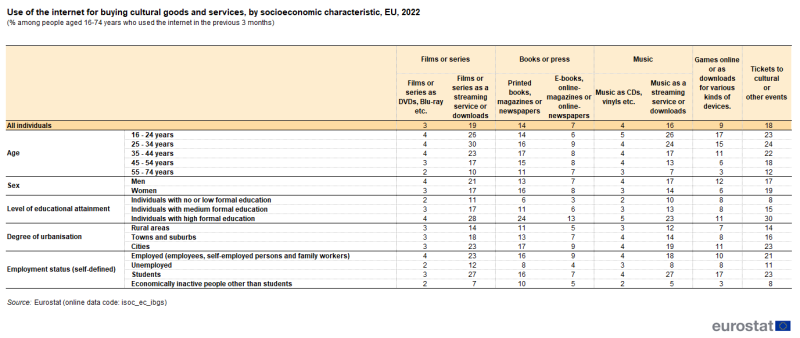
(% among people aged 16-74 years who used the internet in the previous 3 months)
Source: Eurostat (isoc_ec_ibgs)
Purchase of digital cultural content online was most popular in the Netherlands, Ireland, and Denmark
According to 2022 data, the most bought online cultural products in most EU countries were films (or series) accessible via streaming or downloadable, followed by music as a streaming service or downloads. The least often bought were films or series as DVDs, Blu-ray, etc.
In 2022, the Netherlands, Ireland, and Denmark were among the EU countries with the highest percentages of internet users who bought cultural contents online in most of the categories analysed. Conversely, low percentages of individuals who bought online cultural goods or services were seen in Bulgaria, Romania, and Latvia.
In 2022, more than half of the internet users in the Netherlands (56 %) and Denmark (51 %), and over 20 % of users in the other nine EU countries made online purchases of films or series as a streaming service or downloads. At least 20 % of internet users in eight EU countries bought music as a streaming service or downloads online. In contrast, physical media with music and video content were most popular in Malta, where 13 % of internet users bought music on CD, vinyl, and similar media, and 12 % bought films or series as DVDs, Blu-ray, etc. In the rest of the EU countries, the share of internet users buying physical copies of music and films online did not exceed 6 %.
Internet users who bought books, magazines, and newspapers online had diverse preferences about the media format of the content. At least one in five internet users in Denmark (22 %), Ireland, and the Netherlands (both 21 %) bought e-books, online magazines, or online newspapers. Similarly, at least one in five internet users in Ireland and the Netherlands (both 25 %), Luxembourg (24 %), and Malta (23 %) bought printed versions of books, magazines, or newspapers online. It should be noted that less than 10 % of individuals from 19 EU countries bought e-books, online magazines, or online newspapers via the internet, and less than 10 % of internet users in nine EU countries bought the physical versions of books, magazines, or newspapers online (see Figure 4).
At the EU level, the gap in the online purchase of digital versus physical cultural goods is particularly clear for audio-visual products. The use of the internet for cultural purchases is predominantly related to digital products in the cases of films, series, and music. In the case of books, even though purchases are increasingly made online, the printed version is still preferred.
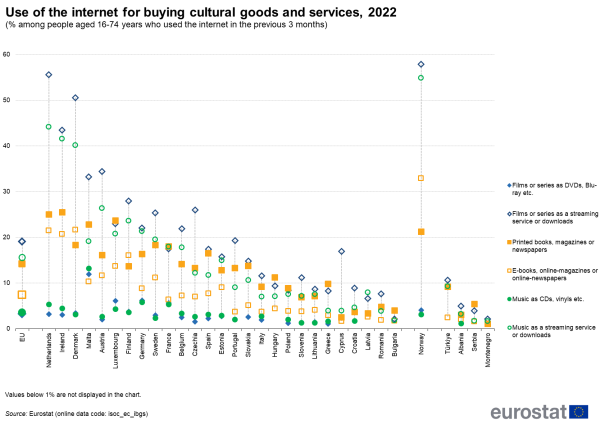
(% among people aged 16-74 years who used the internet in the previous 3 months)
Source: Eurostat (isoc_ec_ibgs)
Source data for tables and graphs
Data sources
All the data in this article are derived from the EU survey on ICT usage in households and by individuals. The survey is conducted every year from 2002 on. The aim of the ICT survey is to provide relevant statistics on areas such as: access to and use of ICTs, use of the internet, use of e-commerce and ICT skills. The data are available according to many breakdown variables including age, by sex, and level of educational attainment. The target population is people aged 16 to 74 years living in private households. See digital economy and society legislation.
Context
Culture is one of Europe's greatest assets: it is a source of values and identity and creates a sense of belonging. It also contributes to well-being, social cohesion and inclusion. The cultural and creative sectors can trigger economic growth, job creation and international trade.
The EU supports these objectives through the Creative Europe programme and several policy actions included in the Work Plan for Culture (2023-2026). The plan, adopted by the Council of Culture Ministers of the EU, sets out the current main priorities for European cooperation in cultural policymaking: empowering the cultural and creative sectors, enhancing cultural participation and the role of culture in society, unleashing the power of culture and strengthening the cultural dimension of the EU external relations. The implementation of the Work Plan for Culture (2023-2026) is supported by optimised use of quality data and statistics.
Notes
Direct access to
- Culture (all Statistics Explained articles on culture)
- Digital economy and society (all Statistics Explained articles on the digital economy and society)
- Digital economy and society statistics - households and individuals
- E-commerce statistics for individuals
- Culture (cult), see:
- Cultural participation and expenditure (cult_pcs)
- Use of ICT for cultural purposes (cult_pcs_ict)
- Individuals - internet activities (isoc_ci_ac_i)
- Internet purchases - goods or services (2020 onwards) (isoc_ec_ibgs)
- Internet purchases by individuals (until 2019) (isoc_ec_ibuy)
- Individuals - internet use (isoc_ci_ifp_iu)
- Regulation (EU) 2021/818 of the European Parliament and of the Council of 20 May 2021 establishing the Creative Europe Programme (2021 to 2027) and repealing Regulation (EU) No 1295/2013
- Regulation (EC) No 2019/1700 establishing a common framework for European statistics relating to persons and households, based on data at individual level collected from samples
- Summaries of EU Legislation: Statistics on the information society (see Annex 2 “Module 2: Individuals, households and the information society”)
- European Council Work Plan for Culture (2023-2026)
- European Council Work Plan for Culture (2019-2022)
- European Council Work Plan for Culture (2015-2018)
- Communication from the Commission to the European Parliament, the Council, the European Economic and Social Committee and the Committee of the Regions on a European agenda for culture in a globalising world (COM(2007) 242)